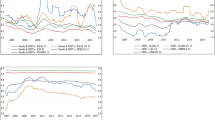Abstract
The art market has seen several booms and busts during the last 20 years and, despite its recent downturn, has received more attention from investors given the low interest environment following the financial crisis. However, participation has been reserved for a few investors and the hedging of exposures remains difficult. This paper proposes to overcome these problems by introducing a call option on an art index, derived from one of the most comprehensive data sets of art market transactions. The option allows investors to optimize their exposure to art. For pricing purposes, non-tradability of the art index is acknowledged and option prices are derived in an equilibrium setting as well as by replication arguments. In the former, option prices depend on the attractiveness of gaining exposure to a previously non-traded risk. This setting further overcomes the problem of art market exposures being difficult to hedge. Results in the replication case are primarily driven by the ability to reduce residual hedging risk. Even if this is not entirely possible, the replication approach serves as a pricing benchmark for investors who are significantly exposed to art and try to hedge their art exposure by selling a derivative.
Similar content being viewed by others
References
Baumol W. (1986) Unnatural value: Or art investment as floating crap game. American Economic Review 76(2): 10–14
Bayraktar E., Young V. (2008) Pricing options in incomplete equity markets via the instantaneous Sharpe ratio. Annals of Finance 4(4): 399–429
Black F., Scholes M. S. (1973) The pricing of options and corporate liabilities. Journal of Political Economy 81(3): 637–654
Breeden D. (1979) An intertemporal asset pricing model with stochastic consumption and investment opportunities. Journal of Financial Economics 7(3): 265–296
Campbell, J. Y., & Shiller, R. J. (2001). Valuation ratios and the long-run stock market outlook: An update, Cowles foundation discussion paper 1295, Cowles Foundation for Research in Economics, Yale University.
Chanel O., Gerard-Varet L., Ginsburgh V. (1994) Prices and returns on paintings: An exercise on how to price the riceless. The GENEVA Papers on Risk and Insurance—Theory 19(1): 7–21
Claus J., Thomas J. (2001) Equity premia as low as three percent? Evidence from analysts’ earnings forecasts for domestic and international stock markets. Journal of Finance 56(5): 1629–1666
Cochrane J., Saa-Requejo J. (2000) Beyond arbitrage: Good-deal asset price bounds in incomplete markets. Journal of Political Economy 108(1): 79–119
Cochrane, J. H. (2006). The dog that did not bark: A defense of return predictability, NBER working papers 12026, National Bureau of Economic Research, Inc.
Daniel, K., & Titman, S. (2000). Market efficiency in an irrational world, NBER working papers 7489, National Bureau of Economic Research, Inc.
Fama E. F. (1970) Efficient capital markets: A review of theory and empirical work. The Journal of Finance 25(2): 383–417
Ginsburgh V.J.M., Moses M. (2006) Handbook of economics of art and culture. In: Ginsburgh V.A., Throsby D. (eds) The computation of prices indices (Chap). Elsevier, North-Holland
Goyal, A., & Welch, I. (2002). Predicting the equity premium with dividend ratios, NBER working papers 8788, National Bureau of Economic Research, Inc.
Henderson V., Hobson D. (2009) Utility indifference pricing—An overview. In: Carmona R. (Ed.) Indifference pricing: Theory and applications (Chap 2). Princeton University Press, Princeton
Higgs H., Worthington A. (2005) Financial returns and price determinants in the Australian art market, 1973–2003. The Economic Record 81(253): 113–123
Hodgson D., Vorkink K. (2004) Asset pricing theory and the valuation of Canadian paintings. Canadian Journal of Economics 37(3): 629–655
Kräussl, R., & van Elsland, N. (2008). Constructing the true art market index. Working paper 2008/11, Center for Financial Studies.
Liu J., Pan J., Wang T. (2005) An equilibrium model for rare-event premia and its implication for option smirks. The Review of Financial Studies 18(1): 131–163
McAndrew C. (2008) The art economy: An investor’s guide to the art market. Liffey Press, Dublin
Mei J., Moses M. (2002) Art as an investment and the underperformance of masterpieces. American Economic Review 92(5): 1656–1668
Merton R. C. (1977) On the pricing of contingent claims and the Modigliani-Miller theorem. Journal of Financial Economics 5(2): 241–249
Renneboog L., Van Houtte T. (2002) The monetary appreciation of paintings: From Realism to Magritte. Cambridge Journal of Economics 26(3): 331–358
Timmermann A., Granger C. W. J. (2004) Efficient market hypothesis and forecasting. International Journal of Forecasting 20(1): 15–27
Author information
Authors and Affiliations
Corresponding author
Additional information
Part of this paper was written while visiting NYU, Stern School of Business.
The authors thank Menachem Brenner, Michael Moses, and Jan Wrampelmeyer for helpful comments
Rights and permissions
About this article
Cite this article
Kraeussl, R., Wiehenkamp, C. A call on art investments. Rev Deriv Res 15, 1–23 (2012). https://doi.org/10.1007/s11147-011-9061-x
Published:
Issue Date:
DOI: https://doi.org/10.1007/s11147-011-9061-x




